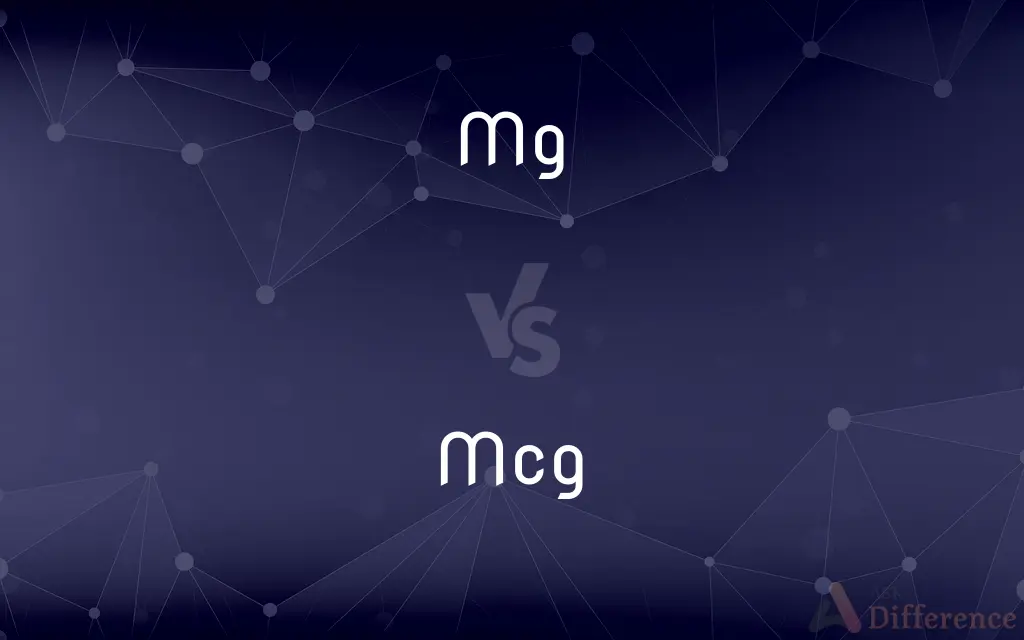MG vs. MCG — What's the Difference?
Edited by Tayyaba Rehman — By Fiza Rafique — Updated on April 17, 2024
MG (milligram) is a unit of mass equal to one thousandth of a gram, used commonly in medicine and science, whereas MCG (microgram) is even smaller, equal to one millionth of a gram.

Difference Between MG and MCG
Table of Contents
ADVERTISEMENT
Key Differences
MG, short for milligram, is a widely used metric unit for measuring small quantities of substances, especially in contexts like pharmaceutical dosing and nutritional information. In contrast, MCG, which stands for microgram, is used to measure even smaller quantities, crucial in medicine for substances effective at very low concentrations.
In terms of scale, a milligram is one-thousandth of a gram, suitable for items that are small but perceptible, like a small pinch of salt. On the other hand, a microgram is one-millionth of a gram, used for amounts that are almost imperceptible, such as certain hormone levels or quantities of a drug.
The precision of measurement in MG is sufficient for everyday substances and some medical dosages. However, the precision of MCG is essential for dealing with highly potent substances, where even a tiny amount can make a significant difference, such as in the dosage of thyroid medication.
Converting between these units is straightforward but critical; 1 milligram equals 1,000 micrograms. This conversion is particularly important in fields like pharmacology, where precise dosing can be the difference between efficacy and toxicity.
Understanding these units can help avoid dosage errors in medical settings, where precision is crucial for patient safety. For example, confusing milligrams and micrograms can lead to a dose being a thousand times too high or too low.
ADVERTISEMENT
Comparison Chart
Unit Size
0.001 grams
0.000001 grams
Common Uses
General medication, food labeling
Highly potent medications, precise scientific measurements
Precision
Suitable for less potent substances
Necessary for highly potent substances
Conversion
1 MG = 1,000 MCG
1 MCG = 0.001 MG
Importance
Common in everyday use
Crucial for high-precision requirements
Compare with Definitions
Mg
Commonly used in medicine to indicate dosage amounts.
Each tablet contains 250 mg of the active ingredient.
Mcg
Crucial in scientific research for extremely small quantities.
The experiment required precisely 2 mcg of the chemical.
Mg
Appropriate for measuring substances when small but significant amounts are needed.
He added 5 mg of salt to the solution.
Mcg
A unit of mass equal to one millionth of a gram.
The dosage of the thyroid medication is 75 mcg daily.
Mg
A unit of mass equal to one thousandth of a gram.
The doctor prescribed 500 mg of ibuprofen for pain relief.
Mcg
Often used in the pharmaceutical industry for potent drugs.
Each vial of the vaccine contains 10 mcg of the active substance.
Mg
Helps in precise but not ultra-sensitive measurements.
The laboratory scales can measure down to 0.1 mg.
Mcg
Used for measuring doses of substances that are effective at very low levels.
The supplement contains 400 mcg of folic acid.
Mg
Used in nutritional information to describe the quantity of vitamins and minerals.
This cereal contains 150 mg of calcium per serving.
Mcg
Essential in environments where ultra-precision is necessary.
The precision balance measures up to 0.01 mcg.
Mg
One thousandth (1/1,000) gram
Mcg
One millionth (1/1,000,000) gram
Mg
A light silver-white ductile bivalent metallic element; in pure form it burns with brilliant white flame; occurs naturally only in combination (as in magnesite and dolomite and carnallite and spinel and olivine)
Common Curiosities
In what situations would you use MCG instead of MG?
MCG is used when dealing with highly potent substances that require precise small-scale dosing.
What is the main difference between MG and MCG?
MG (milligram) is a unit that is 1,000 times larger than a MCG (microgram).
Can a mistake between MG and MCG be dangerous?
Yes, confusing these units can lead to overdosing or underdosing, which can be dangerous or fatal in medical contexts.
Why is it important to differentiate between MG and MCG?
Accurate differentiation prevents dosage errors in medications, which can be critical for patient safety.
What types of products use MCG?
Highly potent pharmaceuticals, certain hormone therapies, and scientific measurements often require micrograms.
Why might a scientist choose to work in MCG rather than MG?
For high precision in chemical and medical research where even minute quantities can affect outcomes.
Is there a visual way to understand the scale of MG and MCG?
Imagine a milligram as a small grain of table salt, whereas a microgram would be a thousand times smaller—virtually undetectable by sight.
How do everyday consumers encounter MG and MCG?
Consumers encounter MG in dietary supplements and medications, while MCG is often seen in the dosage of certain prescription drugs.
How are these units used differently in the food industry?
In food labeling, milligrams might be used to denote the content of less potent nutrients like sodium, whereas micrograms are used for vitamins and minerals needed in smaller quantities.
How do you convert MG to MCG?
To convert milligrams to micrograms, multiply by 1,000 (e.g., 1 mg = 1,000 mcg).
What is a common error when writing MG and MCG?
A common error is placing a period after the abbreviation (mg. or mcg.), which is not necessary.
What types of products typically use MG for measurements?
Over-the-counter drugs, food products, and everyday supplements often list ingredients in milligrams.
What tools are used to measure MG and MCG?
MG is typically measured with standard digital scales, whereas MCG measurements might require more sophisticated, sensitive laboratory scales.
How do medical professionals ensure accuracy with these units?
Medical professionals use careful calculations and double-check dosages, especially when converting between these units.
What impact do these units have on patient treatment plans?
Accurate dosing using these units ensures that patients receive the most effective therapeutic levels of medications without exceeding safety margins.
Share Your Discovery

Previous Comparison
Child vs. Daughter
Next Comparison
Submission vs. ObedienceAuthor Spotlight
Written by
Fiza RafiqueFiza Rafique is a skilled content writer at AskDifference.com, where she meticulously refines and enhances written pieces. Drawing from her vast editorial expertise, Fiza ensures clarity, accuracy, and precision in every article. Passionate about language, she continually seeks to elevate the quality of content for readers worldwide.
Edited by
Tayyaba RehmanTayyaba Rehman is a distinguished writer, currently serving as a primary contributor to askdifference.com. As a researcher in semantics and etymology, Tayyaba's passion for the complexity of languages and their distinctions has found a perfect home on the platform. Tayyaba delves into the intricacies of language, distinguishing between commonly confused words and phrases, thereby providing clarity for readers worldwide.
















































